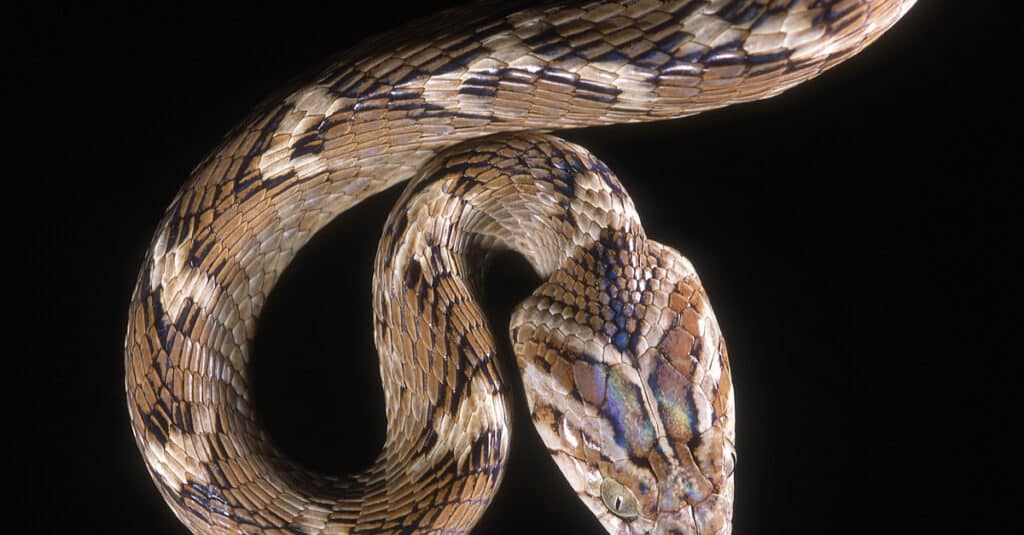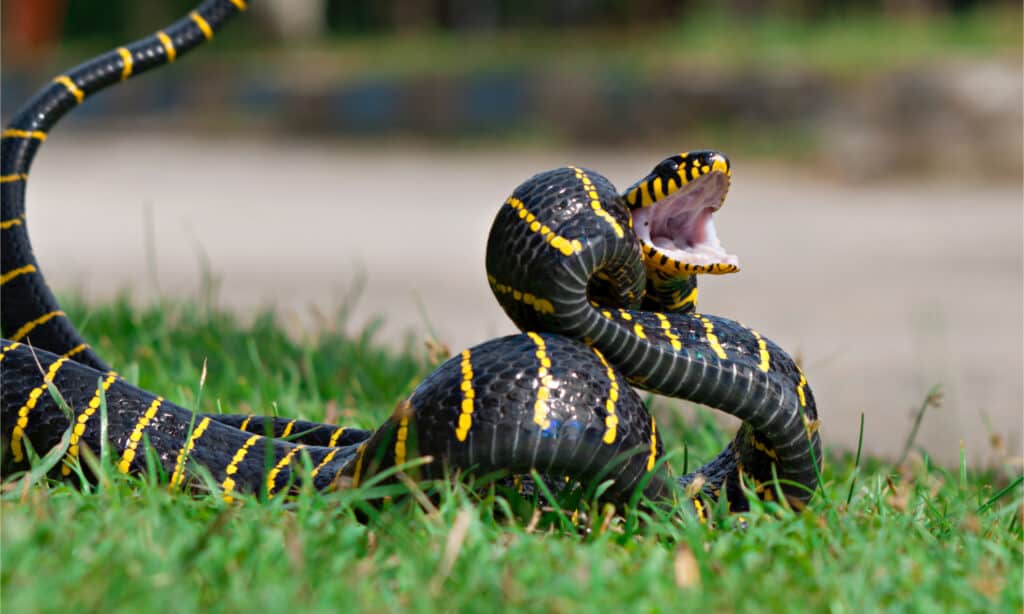Cat Snake
Some cat snakes have a prehensile tail that helps them climb into trees.
Advertisement
Cat Snake Scientific Classification
Read our Complete Guide to Classification of Animals.
Cat Snake Conservation Status
Cat Snake Facts
- Prey
- Rodents, lizards, geckos, frogs, and small birds
- Fun Fact
- Some cat snakes have a prehensile tail that helps them climb into trees.
- Other Name(s)
- Cat snake
Cat Snake Physical Characteristics
- Venomous
- Yes
- Aggression
- Low
View all of the Cat Snake images!
The cat snake is a capable nocturnal hunter with cat-like eyes that help them see well in the dark.
The cat snake can be defined as a loosely related group of many different species within the Colubrid family (Coluber means snake or serpent in Latin). There are so many species that they can be difficult to classify and discuss in a single article. They have a very wide geographic range and body markings. Nevertheless, there are a few general anatomical and behavior features that unite these species together.
5 Amazing Facts
- The cat snake’s pupils will change shape depending on the time of the day. When it is daytime, their pupils will contact into narrow slits that keep out most of the light. During the nighttime, the pupils will expand into a circle and let in more light.
- Depending on the species, the maximum clutch size of these snakes can range up to 15 eggs. These eggs can take several months to hatch. The mother may watch over and incubate the eggs until then.
- Although capable of producing venom, these snakes don’t rely on it for self-defense. When not hunting, they spend most of their day hiding in holes and crevices to avoid predators.
- Some cat snakes have a prehensile tail that helps them climb into trees. They hunt and sleep in this arboreal habitat.
- Like many snakes, these snakes primarily sense the environment through scent, vibrations, and chemical cues in the environment.

Where to Find Cat Snakes
Cat snakes have a massive geographic range extending all over the Eastern Hemisphere. There are generally three types. Eurasian cat snakes of the genus Telescopus are found throughout the driest areas of southeastern Europe, southwestern Asia, and northern Africa. Old World cat snakes of the genus Boiga inhabit Southeast Asia and the Pacific region. The African cat snakes prefer the tropical rainforests and open woodlands of sub-Saharan Africa. One of the few species of these snakes that occurs in Europe is called the Soosan snake or simply the European cat snake. The Soosan snake can be found from the Balkans in the west to the Caucasian Mountains in the east.

The different types of cat snakes live in a wide area that extends all over the Eastern Hemisphere.
©Wirestock Creators/Shutterstock.com
Scientific Name and Different Types of Cat Snakes
The cat eye snakes can be divided into three separate genera: Boiga, Telescopus, and Dipsadoboa. The genus Boiga is the largest and most diverse group with some 35 species; however, the origin of this scientific name is unknown. Telescopus, which means far-sighted in Greek, includes about 12 species. Dipsadoboa, which means something like “thirsty snake,” contributes another 11 species. There is a fourth genus called Leptodeira, better known as the cat-eyed snakes. Although considered to be separate from the cat snakes, they have similar cat-like eyes. All of these genera belong to the Colubrid family. This is the largest and most diverse snake family in the world.
- Boiga – The Boiga is native to Asia, Australia, and India, but they have spread to many other parts of the world. These snakes are highly adaptable and able to survive in many varied environments and mildly venomous.
- Telescopus – The Telescopus is found in several areas from north Eurasia, to western Africa, to Pakistan. The have a thin body that resembles a cylinder. They can be found dwelling in trees and on the ground.
- Dipsadoboa – The Dipsadoboa is also known as Cross-barred Tree Snake. It is mostly found in different regions of Africa. They have splotches of brown skin with a spattering of white dots.

The cat eye snakes can be divided into three separate genera:
Boiga, Telescopus,and
Dipsadoboa.
©Wirestock Creators/Shutterstock.com
Population & Conservation Status
The population numbers of the cat snake have never been properly estimated, but according to the IUCN Red List, the vast majority of species are considered to be either least concern or data deficient (meaning they haven’t been properly classified yet). Only a few species like the banded green cat snake and the Andaman cat snake are endangered in any way. Habitat loss and human persecution are usually the greatest reasons for their decline, but most populations are stable or even increasing.
Appearance & Description
Although this is a very diverse and loosely related group, there are a few definitive characteristics shared by most if not all cat snakes. They are defined most of all by a long and fairly stout body with a triangular head distinct from the neck. They also have the iconic feline-like pupils for which they’re named. The short rear fangs are positioned at the back of the throat and aren’t quite as useful for biting as other types of snakes. Although some species can measure up to 9 feet long, most are usually no longer than 2 to 4 feet. They come in a diverse array of patterns and colors, but many have green, brown, or yellow skin with black or brown markings. There are some unique-looking species in this group. The mangrove snake has a black body with regular yellow rings. The green cat snake has a bright green or yellowish-green body.
Here is how to identify the cat snake:
- Long bodies measuring up to 9 feet.
- Triangular heads.
- Vertical pupils.
- Short rear fangs.
- Green, brown, yellow, and black are the most common colors.

Cat snakes have distinctive triangular heads and their pupils are vertical like a cat’s eye.
©RealityImages/Shutterstock.com
History and Evolution
Similar to other species of snake, cat snakes’ ancestors were actually legged reptiles, similar to lizards and reptiles that spent more time in and near water. As you might have guessed, they either lost their legs or they became vestigial, as they became more and more unused. It is interesting to imagine animals evolving to have legs and then evolving to lose them!
The Cat Snake is a good example of how much a species can evolve differently than its sister species. Usually, this is based on many factors such as food supply, predators, and climate. Animals that we see today have all adapted to their surroundings to thrive and be successful.
How Dangerous Are They?
Despite their appearance, these snakes are not very dangerous to people at all. Their venom is considered to be fairly mild, and they have trouble opening up their mouths wide enough to bite with their rear fangs. The venom can potentially cause pain, swelling, and other mild symptoms. It may be a good idea to seek medical attention, because an allergic reaction may occur. Fortunately, the venom is mostly intended to subdue prey, not defend against potential predators.

Cat Snakes’ venom is considered to be fairly mild, and they have trouble opening up their mouths wide enough to bite with their rear fangs.
©Fernandha Theory/Shutterstock.com
Behavior & Humans
When encountered in the wild, cat snakes are more likely to run away and hide than stand their ground and bite. They tend not to be very aggressive toward people at all. Nevertheless, some species do not like being handled and may become more aggressive than others. If cornered, there is a good chance they will attempt to bite. They generally do not make good pets even when non-aggressive because they tend to be timid and fearful of people.
View all 233 animals that start with CCat Snake FAQs (Frequently Asked Questions)
Are cat snakes venomous?
Yes, but they produce only a mild type of venom.
How do cat snakes hunt?
Cat snakes usually come out at night to hunt, relying on their speed and agility to catch prey. They will usually grasp the prey in the mouth and sink the fangs into its body. The venom will start to work quickly to fully subdue the prey. The snake will tend to swallow the prey whole.
Are cat snakes aggressive?
Unless directly threatened, cat snakes are not very aggressive toward people at all.
Where do cat snakes live?
Cat snakes have a large geographic range all over Asia and Africa; the Soosan snake is also found in Europe. Depending on the genus, they can live in forests, woodlands, mountains or hills, and dry shrub lands or deserts.
What do cat snakes eat?
Cat snakes have a very diverse diet consisting of rodents, lizards, geckos, frogs, and small birds.
Why is a cat snake called a cat snake?
Their vertical pupils look remarkably similar to those of a cat.
Are cat snakes real?
Yes, they’re normal snakes that belong to the Colubrid family. There’s nothing particularly different about them besides their cat-like pupils.
Thank you for reading! Have some feedback for us? Contact the AZ Animals editorial team.
Sources
- Briticannica / Accessed April 23, 2022
- Snake Facts -- Weebly / Accessed April 23, 2022















